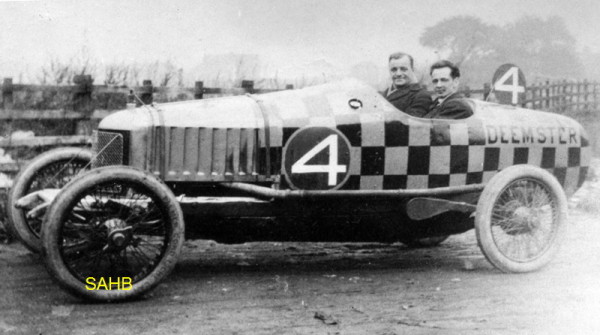
The 200-Mile Race organised by the Junior Car Club that took place at Brooklands in October 1921 was the first event of its type to be held in the British Isles. Competing cars were either in the Voiturette category – up to 1500 cc, or Cyclecars with a maximum capacity 1100 cc. The title of the smaller class was somewhat misleading as although participants such as GN, Morgan, and AV, were of the cyclecar pattern, others are better described as being ‘Light Cars’, this being particularly the case with the Marlborough, Salmson, and Singer entries, plus the Deemster seen here.
Deemster 10hp light cars which had 1087 cc 4-cylinder engines made ‘in house’ had evolved from the Wilkinson and just before the Great War a few had been sold before the firm turned its attention to making portable field kitchens for the military. The business was reorganised after the conflict as the Ogston Motor Co (1918) Ltd, the name coming from that of one of the joint-Directors. It also moved to new premises in Victoria Road, Acton, less than a mile north of the Napier works. There was more to this location connection than it might seem at first glance as a significant number of Deemster employees were ‘ex-Napier’ including Ogston who had been Chief draughtsman at Napier pre-1914, and Mr G E Hester who began as a Napier apprentice in 1902, then rising through the ranks to Senior Foreman, before moving in 1919 to become Works Manager at Deemster.
A friend of the writer’s mother was ‘Auntie Hester’ and her father was this ‘Mr Hester’, as he was only ever known to me, even though visits to him were fairly frequent. It was this gentleman who in the late 1950s gave me the above photograph and described to a youngster who even then had an interest in older cars how he had overseen the meticulous preparation of the race car. It was also Mr Hester who chose the car’s yellow and black checkerboard paint scheme which was certainly eye-catching.
Attention to detail paid off as the Deemster finished the 200-Mile Race in third place in its class – behind the GN of Archie Frazer-Nash and the Salmson – having averaged just over 67 mph, the winning GN’s speed being 71.54 mph. This was a creditable performance which then featured in the firm’s advertising, and it undoubtedly helped sales.
The business was though somewhat undercapitalised and the production cost of the cars, even when British Anzani engines were used from 1922 onwards, meant that the sale price although comparable with that of other quality light cars did not generate sufficient margin and Deemster production ceased in in 1924.






